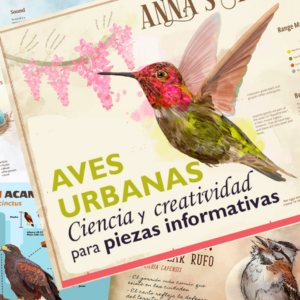 Authors:
Authors:
- Ursula Valdez, she/her, Lecturer Part-Time, Interdisciplinary Arts and Sciences, University of Washington, Bothell campus
- Andrea de la Cruz, Faculty collaborators, Graphic Design, Pontificia Universidad Catolica del Peru
- Andrea Izquierdo, Faculty collaborators, Graphic Design, Pontificia Universidad Catolica del Peru
Project Description
Using the COIL (Collaborative Online International Learning) pedagogy, we created a module within our courses of natural history and graphic design with the goal to promote an interdisciplinary and intercultural learning community for our students from the University of Washington Bothell and the Pontificia Universidad Catolica del Peru. Our module topic focused on the natural history of species that are underestimated in urban ecosystems. The project opened a space for exchanging knowledge and skills among students, and for designing creative visual pieces to be used in public education in their respective communities.
Project Question
Our project addressed common challenges faced by educators:
- Increasing engagement by combining science and art courses and producing high quality and creative deliverables.
- Opening opportunities for a diverse, equally powerful, and intercultural learning community for students from institutions in the USA and Peru.
- Students’ acquisition and sharing of knowledge and skills while directly applying them in meaningful ways. Students created educational pieces that have been used by local non-profit organizations in public environmental education.
Context
A 5-week COIL module offered to undergraduates from UWB and the PUCP in Peru. Remote interactions with students and among them. Online depository of work and constant consultation with faculty and experts. My UWB course was BCORE among the required options for first year students. The module addressed learning goals: assessing accuracy of scientific information; engaging in inquiry; documentation and communication in written/verbal/ creative ways; engaging in intercultural/disciplinary dialog.
Methods
We created a 5-week COIL module used by two different courses. We started the student work by creating mixed “Global teams,” and guiding them to share skills gained within their own disciplines. GT’s goal was producing an infographic of an urban species from Peru or Washington. Infographics were done in both languages spoken by the students. Instructors and students discussed progress along the different stages of the project (brainstorming, planning, design, presentation). Students also received comments from peers and from local experts on the topic. Students, faculty, and local experts communicated synchronously and asynchronously during sessions using platforms such as Zoom and Miro.
Impact/Assessment
Our module was structured as a project-based module for students. They gained some prior knowledge and skills in their respective courses. For the collaborative module, students were given tasks in a scaffolding process, had their progress assessed, and were given feedback all along. We gave opportunities for consultations and to solve questions and issues with the project, along with advice from experts. Thus we assessed the completion of tasks, the application of their skills and knowledge in the collaboration and the ability to complete the final deliverable (an infographic about a species). Students also reflected on their own learning, their challenges and ways to overcome those, and their thoughts on producing materials that were going to be used by the public.
Application
Our work documents the process and the outcomes resulting from the intersection of two distinct disciplines (arts and science), which could be applied between many other fields and contexts. This experience gave us an opportunity as faculty to reflect on our own collaborative learning experience, which is important to do for any educator. In our teaching and learning work, we bring the ideas, skills, creativity, and voices of our students through their own reflections about their learning successes and challenges, all of which helps us to improve and reflect in our own work. Another important aspect we want to share is that, in addition to this collaboration, we partnered with local organizations that will use the students’ pieces as materials for environmental education efforts in urban areas. Our project could be considered a successful example of integrating an interdisciplinary and intercultural learning experience for both faculty and students, and one that also impacts the learning of the local community. We believe that all of these outcomes could inspire faculty from other fields to consider this for their own work.
Additional Insights
This COIL project has been done for 3 quarters now. With our students we have created educational infographics for more than 30 species of birds and mammals within the regions of western WA in the USA, Lima and Puerto Maldonado in Peru and even in Anchorage, AK. Our first year work was profiled by the Husky Highlights also have presented at international meetings.